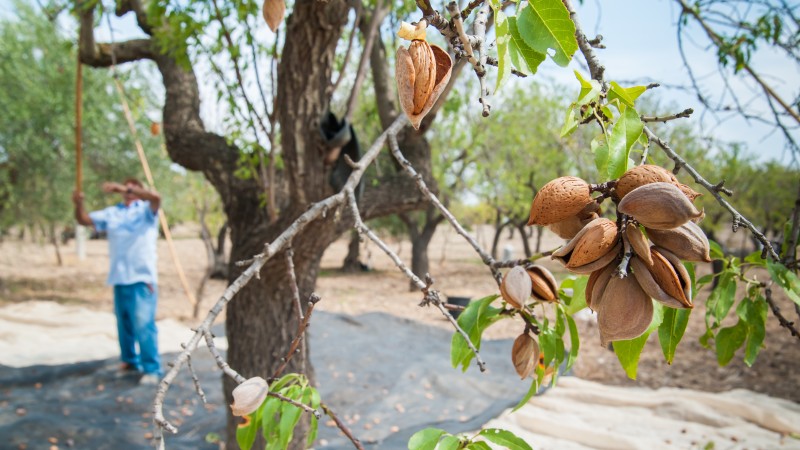Almond Board of California: high demand and hardly any export issues
April 9, 2020 at 8:38 AM ,
Der AUDITOR

Covid-19 currently keeps the world in its thrall, including trade and the markets. What impact does it have on Californian almond production?
Richard Waycott: So far, we cannot really say that the Covid-19 pandemic has a serious impact on the almond production. There are many family companies who do not have a lot of employees in general. The workers are still out in the fields doing their jobs; as there is no need for them to stay together closely, the virus is less likely to spread in those conditions.
In the almond processing facilities, there are generally not many people working at the same place, either. Some years ago, there used to be a lot more people as they had to physically check the quality of the almonds before they were packed. This is mostly done by machines nowadays, not many humans are needed for this kind of work anymore. There is still a small group of people who take a last look, but they can easily be spaced. The same goes for the shipping side. There is one truck driver who brings the almonds to the port, one person who puts them in a container… the amount of people is very limited and on top of those normally spaced out conditions, everyone in the supply chain is taking steps to ensure worker safety given the importance of maintaining a stable supply of food to the public.
What can you tell us about the development of demand? Is it becoming noticeably less and are many orders being cancelled, as we have already heard from other market players?
Richard Waycott: I can confirm that there is definitely a huge uncertainty in the world and also in the markets. Nevertheless, demand for Californian almonds has been very good lately and the factories are running at or near full capacity. Some markets like Japan and South Korea have even asked to ship their orders early which is quite unusual. Domestic demand is still very high as well – about 30% of our production is shipped within the US. Right now, people cannot go out to restaurants, they have to stay at home and therefore do a lot more of fresh cooking. As far as our exports are concerned, there are, however, some issues going on with India.
Talking about logistics and exports: what kind of problems do you have to deal with at the moment, for example, as you just stated, with India? Do strict controls cause exports to stagnate or become noticeably more difficult?
Richard Waycott: The problem with India is that they still have this complete lockdown that usually does not even allow most people to go out for work. There are a few exceptions, of course. At the ports, vessels are currently have difficulty docking and as 12% of our production is exported to India, this certainly does have an impact on us. Nevertheless, there are minor or no problems with other countries as far as border controls are concerned. An issue some countries have to deal with is that their currencies are losing value against the USD, so they have to struggle with higher prices in local currency.
What measures are farmers and producers taking to protect their employees and customers in the current situation? Are special hygiene measures in place?
Richard Waycott: First of all, all workers practice social distancing and maintain the specified distance. People who work in administration or other office operations are either separated or, if possible, work from home, so there are never too many people in one place. Truck drivers who deliver or pick up goods are not allowed to come into the office anymore. This is not a nice situation, but it is certainly necessary.
Market players estimate the new crop at around 2.8 billion lbs. Would you confirm these estimates?
Richard Waycott: There are two official estimates the Almond Board of California issues – one on 12 May and the other one on 7 July, and they are both published by USDA estimates. This means there are no official estimates about the new crop yet, but what I can confirm is that we had a very good blooming period in February and March and plenty of pollination, which is mainly done by honeybees. We had a crop of 2.55 billion lbs last year and expect a larger volume this year, so we are definitely going to have a good crop in 2020.
In Europe, many agricultural factories currently have problems with harvest workers who usually come from abroad. Entry is banned in many countries and the US borders are also largely closed. Could a shortage of harvesters also become a problem for the Californian almond crop?
Richard Waycott: Since the harvesting process for almonds is very mechanical and everything is mostly automated, we do not need a lot of temporary workers for that. There are other arable crops like strawberries where people harvest the fruits by handpicking, and they use to hire migrant workers for that. Our harvest does not start until August anyway, so as of now, I would say this is not going to be a problem for Californian almond farmers. Generally speaking, the migrant labour situation is not in a good place in the US and has not been for many years. Attempts to fix the immigration policy have not been successful yet and even when Mexican migrant workers are needed, it is nearly impossible for them to get visas because the US consulates in Mexico are not issuing immigration documents. But again, the almonds industry is not largely affected by that, it is more a general problem that needs to be fixed.
Thank you very much for taking the time for this interview.
Read also the statement the Almond Board of California gave on the Covid-19 situation.





